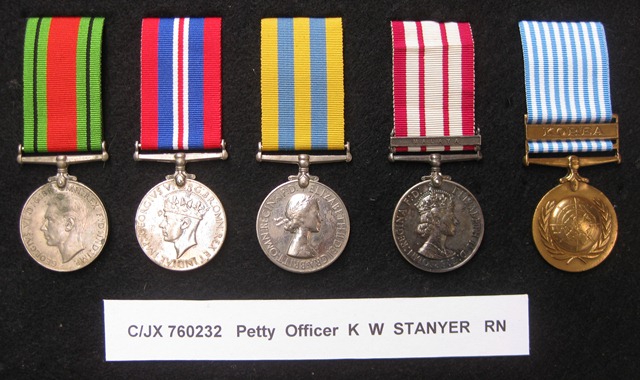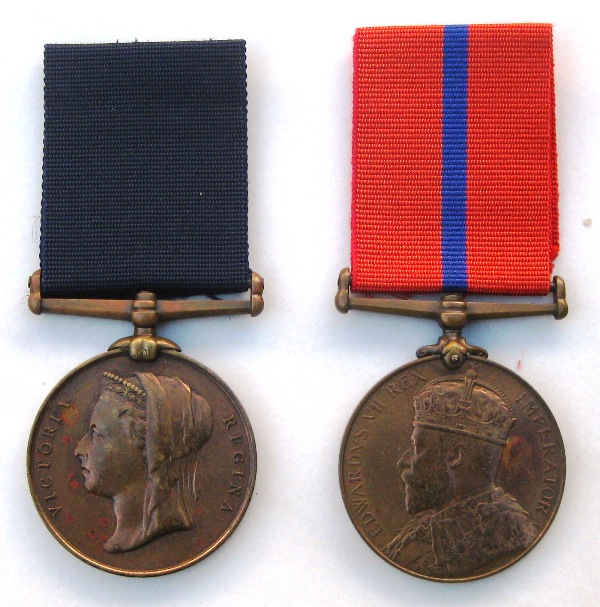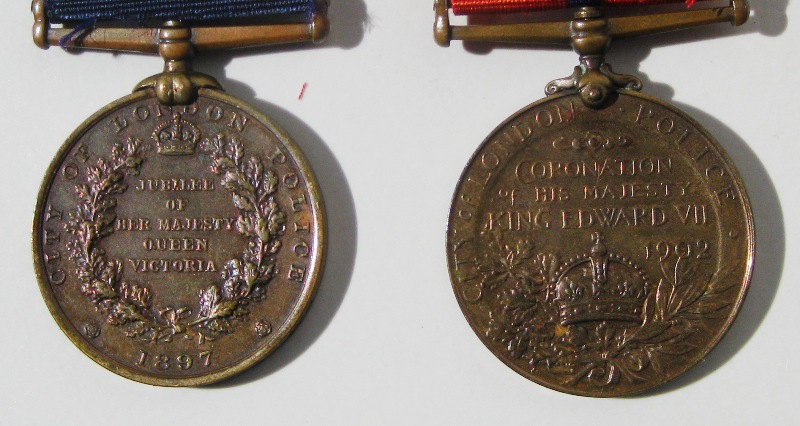-
Posts
858 -
Joined
-
Last visited
-
Days Won
6
Content Type
Profiles
Forums
Blogs
Gallery
Events
Store
Everything posted by Brett Hendey
-
Pieter Thank you for two interesting posts. Although I have British and New Zealand pairs in my Commonwealth Korean War collection, I have yet to add medals to Australians and Canadians. Yee's group is particularly interesting because of his long deployment in Korea, so perhaps he was an interpreter rather than a frontline soldier. The US group that I posted earlier includes the first Purple Heart in my collection. It is a beautiful medal and all the more special because it is named, and it identified the man to whom the group belonged. I see that you are from the Netherlands. I recently purchased a Netherlands Cross for Freedom and Justice for service in Korea on an auction in South Africa, and, later, a Dutch UN Korea Medal that my son is bringing from the UK tomorrow. Since I have been unable to purchase Korea War groups to identified non-Commonwealth troops, I have made up groups to represent the medals that they would have been awarded. In addition to the Dutch pair, I also have made-up groups representing France, Belgium and Ethiopia. Also a single Turkish UN Korea, which was the only medal for the war awarded to Turkish troops. Regards Brett
-
Thank you for responding, John. The Greek and Australian groups are great. I think it has already been recorded elsewhere on this forum, but it is worth repeating that the Korean War was the only war ever fought by the United Nations. The UN has since been present on numerous peace-keeping missions, but not on one side of an armed conflict. This was because the USSR was absent from the UN meeting that voted on the Korean crisis, so was not there to veto the intervention vote. At least, that is what I understand. It was a hard and cruel war, but a very interesting one in part because of the countries that took up arms against North Korea and China (and the USSR in the background). Regards Brett
-
Paul Although only one SA Air Force squadron was deployed in Korea, rotations over the course of the war resulted in a total of 818 men serving there. A total of 35 pilots were killed in action or died in accidents. The SAAF Squadron was integrated with a US Fighter-Bomber Group and flew Mustangs and Sabres. The men received US rather than British Commonwealth awards. They were: Legion of Merit - 3; Silver Star - 2; Distinguished Flying Cross - 55; Cluster to DFC - 1; Soldiers Medal - 1; Bronze Star- 46; Air Medal - 180; Cluster to Air Medal - 104. Republic of Korea awards - 23. In addition, the squadron was awarded both the US Distinguished Unit Citation and the Korean Presidential Unit Citation. Most of the men in the early drafts were World War II veterans. The medal group shown below was that of a ground crewman who served in the RAF during World War II and the SAAF during the Korean War. Regards Brett
-
An excellent group, Michael. Thank you for showing it. The Canadian issue of the Korea Medal is special because it is in silver and has 'Canada' on the obverse. The Korea Medal issued by other Commonwealth countries is in cupro-nickel and the issuing country is not named on the medal. South Africa issued its own Medal for Korea, and it was the last war service medal issued by SA that carried the Royal Cypher on the reverse, and was without the monarch's head on the obverse. This was an indication of the ruling National Party's intention to withdraw SA from the Commonwealth, which it did a few years later. The medal group shown below belonged to B R Leach, a ground crewman with No. 2 Squadron, SAAF, in Korea. Brett
-
Michael The US Army group that I referred to is at the bottom of the page in the link given below: Regards Brett
-
Michael I have really enjoyed reading through this thread. Thank you for keeping it going, and congratulations on completing a fine research project. I recently acquired my first US medal bar. I have a particular interested in the Korean War and the bar belonged to a US Army Corporal who was awarded a Bronze Star and Purple Heart for his service in Korea. It was my most interesting project for a long time, and I now understand the allure of US medal bars. Regards Brett PS I posted my acquisition In the Korean War medal bar thread.
-
John The South African Legion is the main veteran's organisation (they have a website), and also the MOTH's (see link). https://en.wikipedia.org/wiki/Memorable_Order_of_Tin_Hats There is a relatively small and declining number of people in SA's population who have any regard for the country's military history, even with the anti-Apartheid government actions of the African National Congress and Pan-African Congress. The fall of Tobruk was a great disaster for South Africans. I have few pre-1945 memories, but in my later years any talk of WWII seemed to include reference to a family member or friend who was captured at Tobruk. Regards Brett
-
John The Middellandse Regiment was an eastern Cape regiment raised in 1935 with a recruitment area that overlapped with that of the much older Kaffrarian Rifles. Its Afrikaans name suggests it was to accommodate Afrikaans speakers affected by the economic depression at that time. Judging from his names, Bezuidenhout was an Afrikaner. Shown below is the description of the regiment in Major Tylden's book, 'The Armed Forces of South Africa 1659 -1954'. There was a lot of movement between South African regiments during WWII and it is possible that Bezuidenhout was re-assigned to the Kaffrarian Rifles for a reason that can now only be guessed at. Regards Brett
-
I have the medals and some papers of a RN Petty Officer who served in Malaya in 1954/55. In his Federation of Malaya and Colony of Singapore Driver's Licences his address is given as the Military Corrective Establishment at Kinrara. I wondered whether he would have been eligible for the Pingat Jasa Malaysia award? Brett
-
Rob Your records of men such as Sgt Law are their memorials that will hopefully stay with their medals for ages to come. The fact that you are only 21 is very encouraging and I hope that you will continue your good work for a very long time. Your age reminded me that I recently assisted a collector who is not fluent in English to write up the record of a SAAF pilot KiA in North Africa in 1941 when he was only your age.. His medals, Log Book, photographs and other papers had been stored away unlooked at for many years. He had just completed his training when he was posted to Egypt to fly Hurricanes, and after a month or two of uneventful sorties he wrote in a letter about how eager he was to get into a real dog fight. He had his wish fulfilled a week later when his first dog fight also turned out to be his last. His only relatives were his father and a sister, both now long gone, and, except for his name on memorials in Egypt and South Africa, he was forgotten His name is now know to several local people and soon many more will be able to read about his short life. Regards Brett
-
Hi Rob I asked because the Efficiency Medal to South Africans was often awarded to men off active service who stayed on in "Q" Services. When it is named to the regiment it suggests pre-war and wartime service in the regiment to bring up the requisite number of years served for the award. They are "nicer" medals to at least some collectors. Regards Brett
-
I once made a small collection of Jubilee and Coronation Medals, among which was a pair awarded to 694 PC James Allen (Warrant no. 6635). He joined the City of London Police on 2/5/1895, a single man aged 24 years and 6 months. He was appointed to the Fourth Division. He retired unfit on 7/2/1907 with a gratuity of 95 GBP. (Source: City of London Police Warrant Book 1878-2001. Allen's personnel file has not survived. Information provided by Bridget Howlett, Senior Archivist.) Allen's medals are among my favourites, and I once had the hope of collecting more City of London medals, but that was in vain. Brett
-

South Africa medals
Brett Hendey replied to ray11's topic in Great Britain: Orders, Gallantry, Campaign Medals
TOP Queen's Mediterranean Medal - Awarded to Mediterranean garrisons during the Boer War MIDDLE British South Africa Company Medal, Rhodesia 1896 - Awarded for service in the 1896 Rebellion. BOTTOM SOUTH AFRICA MEDAL, 1877-1879 - Awarded for campaigns in the eastern Cape Colony, Transvaal & Natal, including the 1879 Zulu War. There should be names on the rims of the medals, which will be useful in obtaining further information about them. Their commercial value has been considerably reduced by the loss of their suspenders and possible clasps. Regards Brett -
Peter One way of getting nurses in wartime to behave with decorum is to overwork them. An an example, the nurses at the neutral camp hospital during the Boer War's Siege of Ladysmith were so overwhelmed with patients, mainly suffering from typhoid and dysentery, that they barely had time to eat and sleep, so other diversions would have been impossible. Of course, one cannot know what happened after the Siege was lifted and the pressures of work eased .............. Regards Brett
-
AWARDS TO A US ARMY KOREAN WAR SOLDIER The awards shown here were recently purchased on the City Coins (Cape Town) Auction No. 67. They are: Combat Infantry Badge, Bronze Star with “V” emblem, named Purple Heart, National Defence Medal, Korea Service medal with three bronze combat stars, United Nations Korea Medal, South Korea Presidential Unit Citation bar, and enamelled badge of the US 2nd Infantry Division, the “Indianhead” Division (2ID). The awards were made to Corporal Albert S Dion, a Cook in the 23rd Infantry Regiment of the 2ID. Albert Dion was born in Michigan in 1929, and he probably enlisted about 20 years later, because by 1950 he was already a Corporal serving with the 2ID. On 25 June 1950, North Korea, with the support of the Soviet Union and China, invaded South Korea. The 2ID arrived in South Korea a month later, the first unit to reach Korea directly from the United States. There is no direct record of Corporal Dion’s role in the early months of the war when the South Korean and US Armies suffered severe setbacks. They retreated to what became known as the Pusan Perimeter. The rapid introduction of reinforcements from the US and support from other members of the United Nations soon reversed the situation, and the break out from the Pusan Perimeter was led by the 2ID. This unit continued to be in the vanguard of the chase to the Yalu River, which was the border with Manchuria and China beyond. By October 1950, the 2ID was within 50 miles of the Yalu River, and it was then that China deployed its army across the Yalu to rescue the defeated North Koreans.. The surprise attack by huge numbers of Chinese troops sent the UN army into retreat. It was soon after the retreat began that Corporal Dion is mentioned by name in 2ID records with the citation for the award of the Bronze Star with the “V” emblem. It reads as follows: “Corporal Albert S Dion, RA12322159, Infantry, United States Army, a member of Tank Company, 23rd Infantry Regiment, 2nd Infantry Division, distinguished himself by heroic achievement on 25 and 26 November 1950 near Kwang-dong, Korea. During that period, his company was attached to a rifle battalion which was under heavy enemy attack. In the action, the tanks and infantrymen soon exhausted their supply of ammunition and called for more. With no ammunition bearers available, Corporal Dion volunteered to carry ammunition through intense hostile fire to the infantrymen and tankers. With complete disregard for his personal safety, he carried a resupply of ammunition to the defending forces, thus enabling them to keep up the fire and to repel the enemy assault with heavy losses. The heroism displayed by Corporal Dion reflects great credit upon himself and the military service. Entered the military service from Michigan.” Hal Barker of the 23rd Infantry Regiment Association and Korean War Project has written about the action: “This was during the early hours of the Chinese main attack along the Chongchon River at a hill mass known as Chinaman’s Hat near Kuiang. This was a fierce and desperate battle.” The Wikipedia entry for the 2ID records that it had been given the task of defending the rear and right flanks of the retreating United Nations force. After this battle, while surrounded and outgunned, the division had to fight its way south through what was to become known as “The Gauntlet” – a Chinese roadblock 6 miles long where the 23rd Infantry Regiment fired off its stock of 3,206 artillery shells within 20 minutes, a massive barrage that prevented the Chinese troops from following the regiment. This fighting around Kunu-ri cost the division nearly one-third of its remaining strength. The retreat from the Chinese offensive continued and on 4 January 1951 the South Korean capital, Seoul, fell to the enemy for the second time. The advance was finally halted on 31 January, with the 2ID holding the line at Wonju. Dion evidently survived the retreat to Wonju unscathed. The UN forces held their line and then launched a counter-offensive on 5 February. The second, and only other known record of Dion’s service with the 2ID notes that he was “seriously wounded in action by a missile on 6 February 1951”. This evidently happened during the epic battles of Chipyong-ni and Wonju, and it resulted in Dion being awarded the Purple Heart. He was later returned to duty. The 2ID continued to play a leading role in driving the Chinese and North Koreans out of South Korea. In August 1951, the 2ID was involved in the battles of Bloody Ridge and Heartbreak Ridge during which it suffered so many casualties that the ridge warfare strategy was abandoned for the remainder of the war. The 2ID remained in Korea until the end of the war on 27 July 1953, and only returned to the US in 1954 It is not known how long Dion’s service with 2ID continued after he had recovered from his wound. He was awarded three campaign stars on his Korea Service Medal, and they may reflect only the campaigns in 1950 and early 1951, so he may have missed the later 1951 campaigns and those in 1952 and 1953. His discharge date from the army is also not known. A little about Dion’s civilian life has been gleaned from records in the U S Archives. Albert Sylvio Dion was born on 25 November 1929. The 1940 Census results name his parents as George and Cecila Dion, and a brother as Romeo. The family lived in Flint in the County of Genesee, Michigan. Flint was the birthplace of the General Motors Corporation and it owed its former prosperity to this company. It was probably from Flint that Albert Dion enlisted in the US Army, since there is a mention of Genesee County in his records. Albert married Mary Ryan Farmer in Stanislaus County, California, on 27 December 1975. Later, he was living in Ionia, Michigan, where he died on 10 October 2011, aged 81. He was buried in the Saranac Cemetery in Ionia County. Following Albert’s death, Daniel Stebbins of Ionia made use of the Presidential Memorial Certificate Program, which was instituted by President John F Kennedy in 1962, to have such a Certificate issued in his name. This certificate, which carries the facsimile signature of President Obama, came with Albert’s Korean War awards. Albert S Dion, US Army.docx






